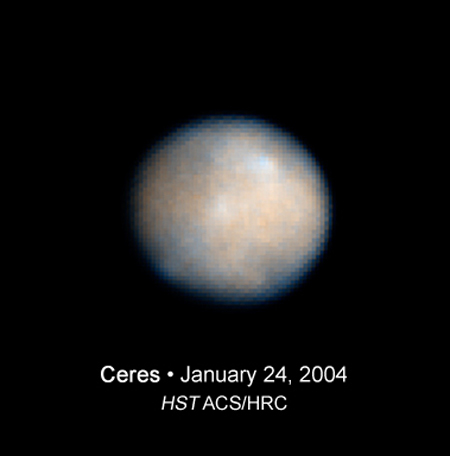New Lander Could Probe Dwarf Planet Ceres For Life

This story was updated at 11:20 a.m. EDT.
Asthe exploration of the solar system progresses, some scientists are consideringmissions to often overlooked worlds. One of these is Ceres, the smallest knowndwarf planet which lies within the asteroid belt.
Investigationshave shown that Ceresis an excellent target for exploration and may even have astrobiologicalsignificance.
Jo?lPoncy is in charge of interplanetaryadvanced projects within the Observation and Science Directorate of ThalesAlenia Space,a European company thatworks on satellitesystems and other orbital infrastructures. This organization has been involvedin many scientific missions, including the Huygens probe, CoRoT, ExoMars, MarsExpress and Venus Express. Poncy and his team, in association with OlivierGrasset and Gabriel Tobie from LPG-Nantes, now have turned their eyes to Ceres.
Ceres Polar Lander
Preliminaryplans for a Ceres Polar Lander are currently being drawn up. The idea is tobuild a low-cost mission using reliable existing technology to complement otherlarger missions, while benefiting from NASA?s Dawn mission results. Assuminglaunch by a Soyuz rocket, the spacecraft would take around four years to reachCeres. It would then enter orbit before attempting a landing.
Poncyadds that ?the lander would separate from the carrier, brake, land close to thetarget site while automatically avoiding boulders and permanent shadows. Wewould then perform an analysis similar that that of NASA?s Mars Phoenix Landerof the surrounding soil and release a mini-rover to explore further.Astrobiological experiments similarto ExoMars can be envisaged.?
Get the Space.com Newsletter
Breaking space news, the latest updates on rocket launches, skywatching events and more!
Maximizing existing technology
Landingan automatic vehicle on Ceres will require some impressive technology, but thisis already in development as part of other projects. Poncy said ?techniques arebeing developed for robotic missions to the South Pole of the Moon, such asESA's MoonNext, for which Thales Alenia Space has been awarded one of the studycontracts.?
ACeres Polar Lander would provide a golden opportunity to transfer at low costthese lunar and Martian technologies for lander, rover and instruments to icymoon-like conditions, thanks to comparable orders of magnitude for gravity andtemperatures at Ceres? poles.
TheCeres poles were considered as the best landing site because interestingmaterial - perhaps including ice - could be present and easily accessible atthe surface. The cold temperature will also more accurately mirror those foundon icy moons. The ultimate design of a Ceres Lander could then be furtheradapted to suit later missions that explore more distant regions of our solarsystem, such as the icy moons Enceladus and Europa.
Poncysuggests that a Ceres Polar Lander could prepare in parallel the next stepbeyond the upcoming Europa Jupiter System Mission and Titan Saturn System Mission. Heexplained that ?these two missions to Jupiter and Saturn are major achievementsto come for mankind and we fully support them. From 2027 to about 2035, theyshould make fantastic discoveries from orbit and on Titan?s surface that willcall for landers on Europa, Ganymede or Enceladus to arrive soon afterwards. Weshould be ready for that, and not plan on landing in 2060! This is too what motivates us, combined with the opportunity to find something major at Ceres."
Potential for alien life
This?major? discovery could be the Holy Grail for astrobiologists: alien organisms.
Poncyexplained that ?with current knowledge, Ceres should have life's mainingredients: organics and a significant fraction of H2O. The question mark isenergy.? ?Astrobiologists believe that life needs a source of energy, and it isa mystery whether this energy is available on Ceres.
Onepossible way Ceres might provide the necessary energy is through a geologicalprocess where rocks oxidize and produce heat. Sunlight reaching the surface andradioactive decay are also options. Poncy admitted that ?although theprobability of life on Ceres is lower than on Europa and Enceladus, which arefavored by their tidal energy, or on Titan - which has huge quantities oforganics - it should not be neglected.?
Iflife does exist on Ceres, what would it be like? Poncy mused that ?nobody canreasonably expect more than microbial life. A mission there could basicallysearch for water/carbon-based ?life-as-we-know-it?. For more exotic forms, somehave floated the idea of clay-based life on Earth as precursor of ?our? life,and there seems to be a lot of clay on Ceres.?
- Video - Dawn: Up Close to Ceres and Vesta
- Dawn to Split Asteroid Differences
- Drilling Down to Alien Oceans
Join our Space Forums to keep talking space on the latest missions, night sky and more! And if you have a news tip, correction or comment, let us know at: community@space.com.

Lee Pullen is a science writer and communicator from the city of Bristol, UK. He has a degree in Astronomy and a master’s in Science Communication. He has written for numerous organizations, including the European Space Agency and the European Southern Observatory. In his spare time Lee enjoys taking photos of the night sky, and runs the website Urban Astrophotography.









